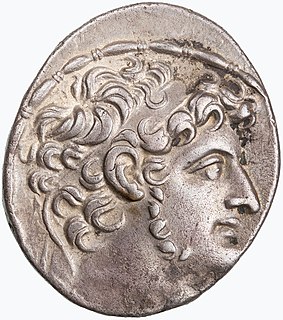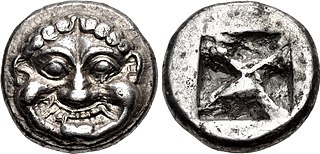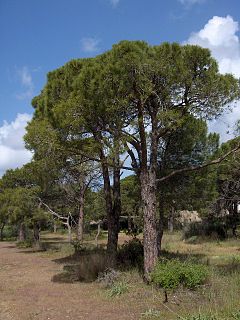Related Research Articles

Numismatics is the study or collection of currency, including coins, tokens, paper money, medals and related objects.

Demetrius III Theos Philopator Soter Philometor Euergetes Callinicus was a Hellenistic Seleucid monarch who reigned as the King of Syria between 96 and 87 BC. He was a son of Antiochus VIII and, most likely, his Egyptian wife Tryphaena. Demetrius III's early life was spent in a period of civil war between his father and his uncle Antiochus IX, which ended with the assassination of Antiochus VIII in 96 BC. After the death of their father, Demetrius III took control of Damascus while his brother Seleucus VI prepared for war against Antiochus IX, who occupied the Syrian capital Antioch.

Alexander II Theos Epiphanes Nikephoros was a Hellenistic Seleucid monarch who reigned as the King of Syria between 128 BC and 123 BC. His true parentage is debated; depending on which ancient historian, he either claimed to be a son of Alexander I or an adopted son of Antiochus VII. Most ancient historians and the modern academic consensus maintain that Alexander II's claim to be a Seleucid was false. His surname "Zabinas" (Ζαβίνας) is a Semitic name that is usually translated as "the bought one". It is possible, however, that Alexander II was a natural son of Alexander I, as the surname can also mean "bought from the god". The iconography of Alexander II's coinage indicates he based his claims to the throne on his descent from Antiochus IV, the father of Alexander I.

Antiochus X Eusebes Philopator was a Seleucid monarch who reigned as King of Syria during the Hellenistic period between 95 BC and 92 BC or 89/88 BC. He was the son of Antiochus IX and perhaps his Egyptian wife Cleopatra IV. Eusebes lived in a period during which there was a general disintegration of Seleucid Syria characterized by civil wars, foreign interference by Ptolemaic Egypt and incursions by the Parthians. Antiochus IX was killed in 95 BC at the hands of Seleucus VI, the son of his half-brother and rival Antiochus VIII. Antiochus X then went to the city of Aradus where he declared himself king. He avenged his father by defeating Seleucus VI, who was eventually killed.

Antiochus XI Epiphanes Philadelphus was a Seleucid monarch who reigned as King of Syria between 94 and 93 BC, during the Hellenistic period. He was the son of Antiochus VIII and his wife Tryphaena. Antiochus XI's early life was a time of constant civil war between his father and his uncle Antiochus IX. The conflict ended with the assassination of Antiochus VIII, followed by the establishment of Antiochus IX in Antioch, the capital of Syria. Antiochus VIII's eldest son Seleucus VI, in control of western Cilicia, marched against his uncle and had him killed, taking Antioch for himself, only to be expelled from it and driven to his death in 94 BC by Antiochus IX's son Antiochus X.

The Taurini were a Celto-Ligurian tribe dwelling in the upper valley of the river Po, around present-day Turin, during the Iron Age and the Roman period.

The history of ancient Greek coinage can be divided into four periods: the Archaic, the Classical, the Hellenistic and the Roman. The Archaic period extends from the introduction of coinage to the Greek world during the 7th century BC until the Persian Wars in about 480 BC. The Classical period then began, and lasted until the conquests of Alexander the Great in about 330 BC, which began the Hellenistic period, extending until the Roman absorption of the Greek world in the 1st century BC. The Greek cities continued to produce their own coins for several more centuries under Roman rule. The coins produced during this period are called Roman provincial coins or Greek Imperial Coins.
The bes was an Ancient Roman bronze coin produced during the Roman Republic. Valued at two thirds of an as, it was only produced in 126 BC by C. Cassius in combination with the dodrans, another very rare denomination which was valued at three quarters of an as. The obverse head displayed the god Liber facing to the right.

The Kingdom of Kuninda was an ancient central Himalayan kingdom documented from around the 2nd century BCE to the 3rd century, located in the southern areas of modern Himachal Pradesh and far western areas of Uttarakhand in northern India.

Cleopatra II Selene was the Queen consort of Egypt from 115 to 102 BC, the Queen consort of Syria from 102–92 BC, and the monarch of Syria from 82 to 69 BC. The daughter of Ptolemy VIII and Cleopatra III of Egypt, Cleopatra Selene was favoured by her mother and became a pawn in Cleopatra III's political manoeuvres. In 115 BC, Cleopatra III forced her son Ptolemy IX to divorce his sister-wife Cleopatra IV, and chose Cleopatra Selene as the new queen consort of Egypt. Tension between the king and his mother grew and ended with his expulsion from Egypt, leaving Cleopatra Selene behind; she probably then married the new king, her other brother Ptolemy X.
Usellus is a town, comune (municipality) and former bishopric in the Province of Oristano in the Italian region Sardinia.
Michael Hewson Crawford, is a British ancient historian and numismatist.

The American Numismatic Society (ANS) is a New York City-based organization dedicated to the study of coins, money, medals, tokens, and related objects. Founded in 1858, it is the only American museum devoted exclusively to their preservation and study. Its collection encompasses nearly one million items, including medals and paper money, as well as the world's most comprehensive library of numismatic literature. The current President of the Society, Dr. Ute Wartenberg, served as the Executive Director for two decades and was succeeded in this role by Dr. Gilles Bransbourg.

Lyrbe was an ancient city and later episcopal see in the Roman province of Pamphylia Prima and is now a titular see.
Gepaepyris was a Thracian princess, and a Roman Client Queen of the Bosporan Kingdom, the longest known surviving Roman Client Kingdom.

Perperene or Perperena was a city of ancient Mysia on the south-east of Adramyttium, in the neighbourhood of which there were copper mines and good vineyards. It was said by some to be the place in which Thucydides had died. Stephanus of Byzantium calls the town Parparum or Parparon (Παρπάρων), but he writes that some called the place Perine. Ptolemy calls it Perpere or Permere. According to the Suda, Hellanicus of Lesbos, a 5th-century BC Greek logographer, died at Perperene at age 85. At a later date it was given the name Theodosiopolis or Theodosioupolis (Θεοδοσιούπολις).
Pyrrhus III, king of Epirus, was a son of Ptolemy and a grandson of Alexander II. He ascended to the throne in 235 BC. Pyrrhus III was assassinated, and he was then succeeded by his cousin Laodamia, or Deidamia who was the last of the Pyrrhus line. With his death, the male line of the royal family of Epirus became extinct.

Barclay Vincent Head (1844–1914) was a British numismatist and keeper of the Department of Coins and Medals at the British Museum.
Agnes Baldwin Brett was an American numismatist and archaeologist who worked as the Curator at the American Numismatic Society from 1910 to 1913. She was the first paid curator at the American Numismatic Society. She made important contributions to the study of ancient coinage, medals, and sculpture, whose work was used by later archaeologists. Brett was also a visiting lecturer of archaeology at Columbia University in 1936.

Salem is a small Welsh village in Ceredigion, located between the Afon Stewi and Nant Seilo rivers. The closest village is Penrhyn-coch.
References
- ↑ Blasco Ferrer, Eduardo (2019-04-01). "Africa, Sardinia, Sicily: Consistencies and Idiosyncrasies in pre-Roman, Latin, Greek, and Arabic". Romance Philology. 73 (1): 37–68. doi:10.1484/J.RPH.1.117799. ISSN 0035-8002.
- ↑ Head, Barclay V. (1882). "THE COINS OF ANCIENT SPAIN". The Numismatic Chronicle and Journal of the Numismatic Society. 2: 183–194. ISSN 2054-9172.